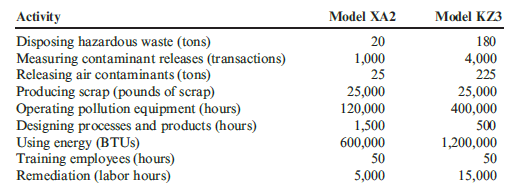Refer to Problem 14.43. In 20x3, Jack Carter, president of Kartel, requested that environmental costs be assigned
Question:

During 20x3, Kartel€™s division produced 200,000 units of Model XA2 and 300,000 units of Model KZ3.
Required:
1. Using the activity data, calculate the environmental cost per unit for each model. How will this information be useful?
2. Upon examining the cost data produced in Requirement 1, an environmental engineer made the following suggestions: (1) substitute a new plastic for a material that appeared to be the source of much of the hazardous waste (the new material actually cost less than the contaminating material it would replace), and (2) redesign the processes to reduce the amount of air contaminants produced.
As a result of the first suggestion, by 20x5, the amount of hazardous waste produced had diminished to 50 tons, 10 tons for Model XA2 and 40 tons for Model KZ3. The second suggestion reduced the contaminants released by 50 percent by 20x5 (15 tons for Model XA2 and 110 tons for Model KZ3). The need for pollution equipment also diminished, and the hours required for operating this equipment for Model XA2 and Model KZ3 were reduced to 60,000 and 200,000, respectively. Calculate the unit cost reductions for the two models associated with the actions and outcomes described (assume the same production as in 20x3). Do you think the efforts to reduce the environmental cost per unit were economically justified? Explain.
Step by Step Answer:

Cornerstones of Cost Management
ISBN: 978-1305970663
4th edition
Authors: Don R. Hansen, Maryanne M. Mowen





